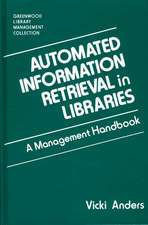Technology for the School Librarian: Theory and Practice
Autor William O. Scheerenen Limba Engleză Paperback – 21 ian 2010 – vârsta până la 17 ani
Preț: 301.09 lei
Preț vechi: 366.53 lei
-18% Nou
Puncte Express: 452
Preț estimativ în valută:
57.61€ • 60.16$ • 47.57£
57.61€ • 60.16$ • 47.57£
Carte tipărită la comandă
Livrare economică 15-29 aprilie
Preluare comenzi: 021 569.72.76
Specificații
ISBN-13: 9781591589006
ISBN-10: 1591589002
Pagini: 240
Dimensiuni: 178 x 254 x 15 mm
Greutate: 0.5 kg
Editura: Bloomsbury Publishing
Colecția Libraries Unlimited
Locul publicării:New York, United States
ISBN-10: 1591589002
Pagini: 240
Dimensiuni: 178 x 254 x 15 mm
Greutate: 0.5 kg
Editura: Bloomsbury Publishing
Colecția Libraries Unlimited
Locul publicării:New York, United States
Caracteristici
Provides a chronology tracing the development of technology in school libraries
Notă biografică
William O. Scheeren, PhD, is a lecturer in education at St. Vincent College, Latrobe, PA.
Cuprins
Chapter 1: School Libraries in the "Bad Old Days"Why Computer Technology Is ImportantHow Technology Has Changed the School LibraryLevels of Technology AcceptanceThe Evolution of Technology in the School LibraryCirculation SystemsSecurity SystemsCataloging, Library Systems, and MARCPersonal ComputersAudiovisual Equipment and MaterialsInternet and Electronic ResourcesWeb 2.0ResourcesQuestions for Research and DiscussionChapter 2: Technology Skills for School LibrariansThe Role of the School LibrarianComputer Skills in ContextSchool Libraries: An Under-Resourced ResourceGeneral Technology SkillsIntroductionBasic Technology SkillsAdditional Technology SkillsWhat Can Library Schools Do?Specific Technology Skills for School LibrariansColorado Technology SkillsClosing ThoughtsResourcesQuestions for Research and DiscussionChapter 3: Networks, Hardware, and Software for School LibrariesNetworksWhat Is a Network?Home NetworksLocal Area NetworksWide Area NetworksLANs versus WANs in the School LibraryNetwork TopologyBus TopologyRing TopologyStar TopologyNetworking BasicsNetwork ArchitectureNetwork ComponentsTransmission MediaNetwork AdaptersNetwork NavigationNetworking SoftwareConnecting to the InternetDial-Up ConnectionsBroadband ConnectionsFat and Thin ClientsComputer HardwareTypes of ComputersInside the ComputerComputer PeripheralsStorage DevicesMonitorsSound DevicesPrintersScannersStudent ComputersTypes of Student ComputersDesktop ComputersNotebook ComputersTablet ComputersHandheld DevicesNetbooksSpecifications for Student ComputersSoftwareOperating SystemsMicrosoft WindowsMacintosh Operating SystemLinuxProductivity SoftwareCommunication SoftwareAntivirus SoftwareGraphics SoftwareInternet BrowsersWeb Development SoftwareSpyware Removal SoftwareConclusionResourcesQuestions for Research and DiscussionChapter 4: Planning for Technology in the School LibraryWhat a Technology Plan Can BeEffective Technology PlanningHow Not to Do a Technology PlanCreating an Effective Technology PlanRules for Technology PlanningMaking Technology Planning WorthwhileIndications of Successful Technology Planning for e-Rate FundingConstructing the Technology PlanSchool Library Technology PlansBuilding the Technology EnvironmentUpdating an Existing Technology PlanStructure of the Technology PlanFunding Technology and Technology PlansGeneralNontraditional Funding IdeasGrantsRole of the School District Technology CoordinatorResourcesQuestions for Research and DiscussionChapter 5: Copyright, Plagiarism, Internet Filtering, and Security SystemsCopyright: IntroductionMyths about CopyrightFair UseDealing with Copyright Issues and Creating a Copyright PolicyDigital ContentPlagiarism and the World Wide WebFiltering SoftwareIntroductionInternet Filters and Their FunctionAlternatives to Filtering SystemsLibrary Security SystemsTypes of Security SystemsAdvances in Library Security SystemsResourcesQuestions for Research and DiscussionChapter 6: Library Information SystemsWhat Makes Up a Library Information System?How Schools Are Using Library Information SystemsAdvantages, Disadvantages, and Possible Improvements for Library Information SystemsAdvantages of Library Information SystemsDisadvantages or Problems with Library Information SystemsHow to Improve the Library Information SystemSelecting a Library Information SystemQuestions to AskLibrary Management System Vendor ChecklistThe Future of Library Information SystemsResourcesQuestions for Research and DiscussionChapter 7: School Library Web SitesTough Questions, Many SuggestionsHow to Create the School Library Web PageWeb DesignWeb Page DesignVisual ConsiderationsPractical ConsiderationsWeb Site Design Errors; Or, Ugh, What an Ugly SiteWeb Design and the LawWhat Should Be on a School Library Web PageRevising or Redesigning Your Web SiteIntranetsResourcesQuestions for Research and DiscussionChapter 8: Digital LibrariesCharacteristics of Digital LibrariesDigital Libraries and Online EducationDigital Libraries versus Traditional LibrariesDigital Contents: General ConsiderationsDigital Contents: Specific Areas and ResourcesAdvantages of a Digital LibraryPossible Disadvantages of Digital LibrariesResourcesQuestions for Research and DiscussionChapter 9: Online Materials for the School LibraryOPACsDatabasesThe Leap to Periodical DatabasesAdvantages and Disadvantages of Online Periodical DatabasesMaking Decisions to Purchase Database Subscriptionse-JournalsElectronic Books (e-Books)Invisible WebGood Online MaterialsGoogle ScholarGoogle EarthResourcesQuestions for Research and DiscussionChapter 10: Creation of Online MaterialsCategories of Online MaterialsA New Paradigm for Library OrientationMore Online MaterialsResourcesQuestions for Research and DiscussionChapter 11: Integrating Technology into the CurriculumWhy Use Technology in the Curriculum?Attributes of Information-Age SchoolsApproaches to IntegrationIntegrating Technology into the CurriculumProsConsStrategies for Integration of Technology into the CurriculumProductivity SoftwareGames and SimulationDrill and PracticeTutorialsDiscussionDiscovery, Problem Solving, and Cooperative LearningDiscipline-Based Ideas for Integration of Technology into the CurriculumElementarySecondaryEnglishMathematicsScienceSocial StudiesForeign LanguageMusicTech EducationResourcesQuestions for Research and DiscussionChapter 12: Web 2.0 and Related TechnologyIntroduction to Web 2.0Library and School Library 2.0Social NetworkingTwitterBlogsWikisPodcastingVirtual ConferencingCourse Management SystemsVirtual Sites with AvatarsResourcesQuestions for Research and DiscussionChapter 13: The School Librarian, Technology, and the FutureTechnology for TeachersTechnology for InclusionTechnology Innovations: The Twenty-First Century and BeyondResourcesQuestions for Research and DiscussionIndex
Recenzii
Sharing actual case studies as well as practical tips on technology implementation and terminology, this title will be a valuable resource to any school librarian. Recommended.
Technology for the School Librarian will be a helpful text for new school librarians.
Technology for the School Librarian will be a helpful text for new school librarians.





















